 Website:
Aesculap®
Website:
Aesculap®
Group: B. Braun Melsungen
Catalog excerpts

Aesculap® AS Advanced Surface 7 Layers to Protect You Aesculap Orthopaedics
Open the catalog to page 1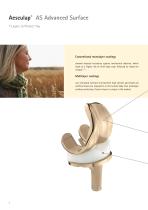
Aesculap® AS Advanced Surface 7 Layers to Protect You Conventional monolayer coatings showed reduced resistance against mechanical ablation, which on, y leads to a higher risk of third body wear followed by metal ion release. (1, 2) Multilayer coatings can withstand corrosive environment high stresses and strains all es dy. artificial knees are exposed to in the human body. This multilayer he coating consisting of seven layers is unique in the market.
Open the catalog to page 2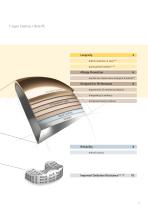
metal ion release below biological threshold (11) prevention of mechanical ablation improved elastic modulus bond coating Improved Oxidation Resistance (12,
Open the catalog to page 3
Longevity – Ceramic Surface 65 % Reduction in Wear Wear is the number one reason for long term revision. (14) AS knee demonstrates 65 % reduction in wear when compared to a CoCrMo prosthesis. (3, 4) Wear rate (mg/Mc) Fig.1: Wear reduction with Columbus® CR and univation® M after 5 Mio cycles according ISO standard 14243-1/3 (3, 4, 11)
Open the catalog to page 4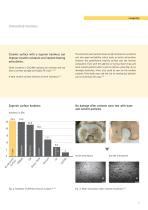
Unmatched Hardness Ceramic surface with a superior hardness can improve scratch resistance and implant bearing articulation. Small scratches in CoCrMo implants are common and can lead to surface damage and higher PE wear. (15, 16) A hard ceramic surface improves scratch resistance. (11) Superior surface hardness The extremely hard surface shows a high resistance to scratches and also good wettability, which leads to better articulation between the polyethylene bearing surface and the femoral component. Even with the addition of cortical bone chips and bone cement particles after 5 and 5.5...
Open the catalog to page 5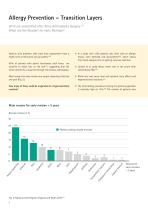
Allergy Prevention – Transition Layers 20 % are unsatisfied after Knee Arthroplasty Surgery. (17) What are the Reasons for early Revision? ❚ In a study with 1335 patients only 30 % with an allergic Patients with problems after total knee replacement have a higher level of chromium ions (p=0.001). (18) history were detected and documented (20), which shows that metal allergies still are getting very low attention. 60 % of patients with poorly functionary total knees are sensitive to metal ions on the skin (19), suggesting that the metal sensitivity is acquired through the primary...
Open the catalog to page 6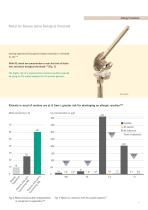
Allergy Prevention Metal ion Release below Biological Threshold develop hypersensitivity against implant materials is estimated to 4 %. (24) With AS, metal ion concentration is near the level of detection and below biological threshold. (11) (Fig. 7) The higher risk of a hypersensitive reaction could be reduced by using an AS coated implant for all revision patients. Patients in need of revision are at 6 time´s greater risk for developing an allergic reaction (20) Metal sensitivity in % CoCrMo AS coated AS reference *level of detection Fig. 6: Metal sensitivity after endoprosthesis in...
Open the catalog to page 7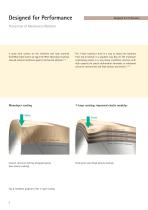
Prevention of Mechanical Ablation A quite hard surface on the relatively soft base material (CoCrMo) might lead to an egg shell effect. Monolayer coatings showed reduced resistance against mechanical ablation.(1, 2) The 7-layer coating is built in a way to reduce the hardness from top to bottom in a gradient way (Fig. 8). The multilayer engineering results in a very dense crystalline structure with high capacity for plastic deformation favorable to withstand corrosive environment and high stresses and strains.(11, 25) Monolayer coating 7-layer coating: improved elastic modulus Column...
Open the catalog to page 8
Bond Coating The bonding layer between CoCrMo and transition coating forms an alloy compound with the base material promoting superior adhesion. AS Advanced Surface is a real enhancement of coating te technologies.
Open the catalog to page 9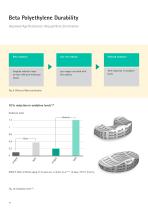
Beta Polyethylene Durability Improved Age Resistance through Beta Sterilization Beta radiation Less free radicals Reduced oxidation Targeted radiation leads to more linking of molecular chains Less oxygen can bond with free radicals 70 % reduction in oxidation levels Fig. 9: Effects of Beta sterilization 70 % reduction in oxidation levels (13) Oxidation index ASTM F 2003: artificial aging of 10 years acc. to Kurtz et al. (12): 14 days / 70°C / 5 bar O2
Open the catalog to page 10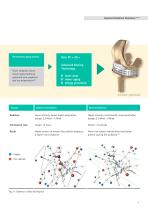
Improved Oxidation Resistance 12, 13 Decelerated aging process Fewer oxidation means slower aging leading to optimized wear properties and less delamination (27) Beta PE + AS = Advanced Bearing Technology ❚ lower wear ❚ slower aging ❚ allergy prevention AS e.motion®, mobile bearing Gamma sterilization Beta sterilization Lower intensity, deeper higher penetration, dosage: 2.5 Mrad – 4 Mrad Higher intensity, concentrated, lower penetration, dosage: 2.5 Mrad – 4 Mrad Sterilization time Higher content of residual free radicals leading to a higher risk of oxidation Fewer free residual radicals...
Open the catalog to page 11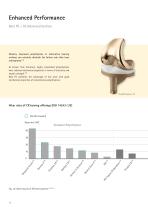
Enhanced Performance Beta PE + AS Advanced Surface Sharkey ‚Improved polyethylene or alternative bearing surfaces can certainly diminish the failure rate after knee arthroplasty.‘ (7) As known from literature, highly crosslinked polyethylenes have reduced mechanical properties in terms of elasticity and impact strength. (27) Beta PE combines the advantage of low wear with good mechanical properties of conventional polyethylenes. Wear rates of CR bearing offerings (ISO 14243-1/3) Fig. 12: Wear results of CR knee systems (11, 28-37)
Open the catalog to page 12
Highly Crosslinked Polyethylene The AS coating in combination with Aesculap Knee Arthroplasty systems with Beta PE yields superior performance. Beta Polyethylene
Open the catalog to page 13
Raimondi MT, Pietrabissa R. The in-vivo wear performance of prosthetic femoral heads with titanium nitride coating. Biomaterials. 2000 May;21(9):907-13. Harman MK, Banks SA, Hodge WA. Wear analysis of a retrieved hip implant with titanium nitride coating. J Arthroplasty. 1997 Dec;12(8):938-45. Sharkey PF, Hozack WJ, Rothman RH, Shastri S, Jacoby SM. Insall Award paper. Why are total knee arthroplasties failing today? Clin Orthop Relat Res. 2002 Nov;(404):7-13. White SE, Whiteside LA, McCarthy DS, Anthony M, Poggie RA. Simulated knee wear with cobalt chromium and oxidized zirconium knee...
Open the catalog to page 14All Aesculap® catalogs and technical brochures
-
proGAV ® 2.0
36 Pages
-
Targon® FN
36 Pages
-
AESCULAP® NEUROENDOSCOPY
128 Pages
-
AESCULAP® Metha®
28 Pages
-
AESCULAP® BULLDOG CLIPS
8 Pages
-
Quintex®
8 Pages
-
MONOMAX®
16 Pages
-
Premilene® Mesh Plug
8 Pages
-
AESCULAP® Excia® 12/14
18 Pages
-
VascuFlex®
12 Pages
-
Aesculap Aeos®
16 Pages
-
LC – LINEAR CUTTER STAPLER
6 Pages
-
M.blue®
44 Pages
-
Nelson® deluxe
8 Pages
-
CARDIOLOGY
44 Pages
-
Aesculap® Targon® RF
28 Pages
-
Aesculap® OrthoPilot®
52 Pages
-
TrendHip®
16 Pages
-
proSA®
30 Pages
-
activ L®
44 Pages
-
AESCULAP® SINGLE USE PRODUCTS
88 Pages
-
AESCULAP® CoreHip® SYSTEM
36 Pages
-
AdTec® bipolar
8 Pages
-
Aesculap Surgical Instruments
64 Pages
-
EV3.0 CAMERA CONTROL UNIT
12 Pages




































